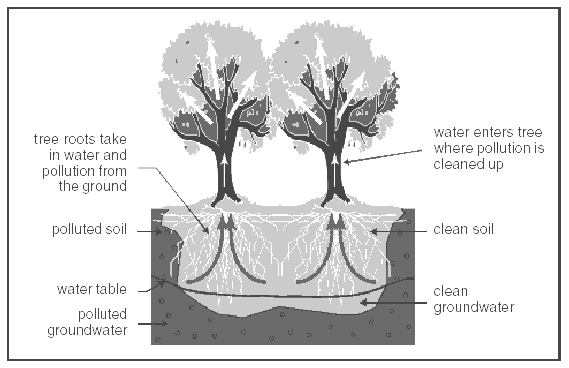
PHYTOREMEDIATION
Using plants to clean up contaminated sites
Phytoremediation
(from Ancient Greek φυτο (phyto), meaning "plant", and Latin remedium, meaning "restoring balance") describes the treatment of environmental problems (bioremediation) through the use of plants that mitigate the environmental problem without the need to excavate the contaminant material and dispose of it elsewhere.
Phytoremediation consists of mitigating pollutant concentrations in contaminated soils, water, or air, with plants able to contain, degrade, or eliminate heavy metals, pesticides, solvents, explosives, crude oil and its derivatives, and various other contaminants from the media that contain them.
Application
Phytoremediation can be applied wherever the soil or static water are polluted.
Phytoremediation correspond to the natural ability of some plants called hyperaccumulators to bioaccumulate, degrade,or make harmless contaminants in soils, air, or water. Some common contaminants like metals, pesticides, solvents, explosives, and crude oil and its derivatives, have been mitigated in phytoremediation projects worldwide. Many plants such as mustard plants, alpine pennycress, hemp, and pigweed have proven to be successful at hyperaccumulating contaminants at toxic waste sites.
Over the past 20 years, this technology has become increasingly popular and has been employed at sites with soils contaminated with uranium, lead and arsenic.
Advantages
- the plants can be easily monitored
- the cost of the phytoremediation is lower than that of traditional processes both in situ and ex situ
- the possibility of the recovery and re-use of valuable metals (by companies specializing in “phyto mining”)
- it is potentially the least harmful method because it uses naturally occurring organisms and preserves the environment in a more natural state.
Limitations
- with plant-based systems of remediation, it is not possible to completely prevent the leaching of contaminants into the groundwater (without the complete removal of the contaminated ground, which in itself does not resolve the problem of contamination)
- phytoremediation is limited to the surface area and depth occupied by the roots
-
slow growth and low biomass require a long-term commitment
- the survival of the plants is affected by the toxicity of the contaminated land and the general condition of the soil.
- bio-accumulation of contaminants, especially metals, into the plants which then pass into the food chain, from primary level consumers upwards or requires the safe disposal of the affected plant material.
Using Native Plants
Use of native plants in phytoremediation provides advantages over other species and helps bring back the heritage of flora lost through human activity. In addition to restoring biodiversity to areas that have been disturbed, remediating Superfund sites using native species provides for wildlife habitat enhancement and conservation and saves money over alternative cleanup methods. Unlike many introduced species, once established, native plants do not require fertilize, pesticides, or watering. The use of native plants in site restoration may serve to restore wetlands and other habitats and create nature parks, sanctuaries, and other green areas.

News 1
News 2
Use of plant roots for phytoremediation and molecular farming
Alternative agriculture, which expands the uses of plants well beyond food and fiber, is beginning to change plant biology. Two plant-based biotechnologies were recently developed that take advantage of the ability of plant roots to absorb or secrete various substances.
FOR MORE INFO SEE ALSO:
Phytoremediatin of heavy metals
http://www.mobot.org/jwcross/phytoremediation/
Mercury and Arsenic example
http://www.mobot.org/jwcross/phytoremediation/
Phytoremediation is often used to slow the movement
of contaminated groundwater. Trees act like a pump,
drawing the groundwater up through their roots to keep
it from moving. This method of phytoremediation is
called “hydraulic control.” It reduces the movement of
contaminated groundwater toward clean areas offsite.

© Copyright Dorde Topalovic. all rights preserved.
18.11.2012.


